
Augmented reality (AR) and virtual reality (VR) have both been deployed successfully throughout warehouses and distribution centers, albeit to achieve different goals.
AR, which overlays virtual elements onto an actual, real-world view as seen by the wearer through clear lens smart glasses, is boosting accuracy, productivity and troubleshooting speed throughout a variety of applications—including picking, sorting, order fulfillment, compliance audits, and maintenance, Augmented and Virtual Realities: repair and operations (MRO) service and training.
VR, which immerses the wearer of a special, enclosed headset into a simulated real-world environment, is principally being used to train employees. It allows them to gain experience and demonstrate proficiency in operating machinery, performing specific tasks or learning new skills in a safe space where mistakes won’t result in an accident, injury or facility damage.
Already making in-roads into supply chain operations, adoption of both technologies accelerated in response to COVID-19. A recent market research report from Technavio expects the combined technologies’ total market size—encompassing both industrial and consumer applications—to grow by $125.19 billion between 2020-2024, a compound annual growth rate (CAGR) of more than 35%.
Eric Abbruzzese, AR/VR research director at ABI Research, attributes much of that growth trend coming from AR technologies, primarily on the consumer side, but with notable investment from companies as well. Remote applications—such as AR remote expertise and AR remote training—will continue to grow in 2021 and lead in terms of adoption rates, he said, projecting that the increase in deployments will drive the overall industrial AR market value to $70 billion by 2025. (By comparison, ABI forecasts consumer AR software and content to grow at over 100% CAGR between 2021 and 2025, reaching $20 billion in total revenue in 2025.)
“The risk of traveling and the experience from the first months of the COVID-19 outbreak will drive demand in 2021 for proactive solutions that increase employee and business efficiency and ensure employee safety,” Abbruzzese noted.
He anticipates that AR software and platform providers will continue to update and expand their offerings. This will include more features and new strategic collaborations to support, automate and simplify large-scale deployments while providing more data and analytics tools for proactive decisions. Enterprise AR hardware will not shift dramatically, as current offerings well serve value use cases.
As for VR adoption, however, Abbruzzese said: “Market elements have not aligned to enable mainstream virtual reality (VR) adoption. Growth will be strong in 2021, but the user base will not reach levels once thought probable since VR competes for usage time with TVs, smartphones and traditional displays. Price and availability of valuable content remain primary barriers.”
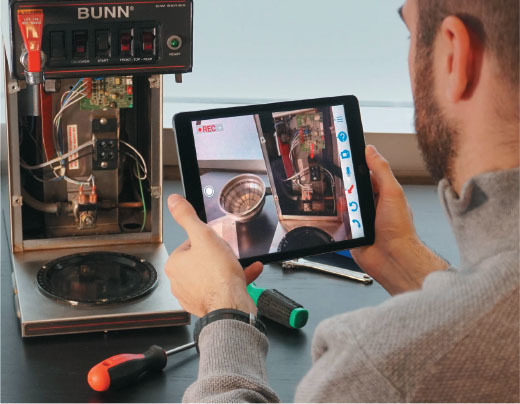

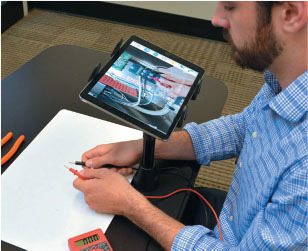
United Service Technologies uses Help Lightning’s merged reality to create a “hands-on” interactive work environment. UNITED SERVICE TECHNOLOGIES
Here is a look at how five different organizations have deployed AR across their global supply chain operations within a variety of applications, including training, remote assistance, compliance audits and order fulfillment. Plus, VR-powered forklift operation training is helping to prepare new distribution center workers to fill high-demand skilled job openings.
Training New Hires and Resolving Customer Issues Faster with AR-Powered Remote Assistance
United Service Technologies (UST) provides field service to support commercial food equipment in the grocery and restaurant industry, with customers including Safeway, Whole Foods, Costco, Panera Bread, Kroger and more. But, like nearly all field service organizations, the company is facing a growing personnel challenge. Specifically, how to optimize and transfer the knowledge of their most seasoned technicians—many of whom are planning their retirements—to the next generation of newly hired field service professionals.
To address these challenges, Rodger Smelcer, COO of UST, sought a new way to reduce new-hire training time. He selected Help Lightning, whose remote assistance app uses a form of AR the company calls “merged reality” to combine the live video streams of field technicians with product experts, creating an interactive work environment. This allows veteran technicians to reach virtually into the field of view and provide “hands-on” guidance to their colleagues or customers.
“We use Help Lightning to bring the field into the classroom,” said Smelcer. “Our new technicians are able to connect with the more experienced technicians in the field and see what they are working on. They are seeing exactly what they are going to be doing in the field and getting to interact with the technician in the field.”
The solution works on existing mobile devices or a web browser, which appealed to UST’s new hires, 70% of whom are Millennials. However, because of how intuitive the system is, even UST’s older generations found it easy to use, he added. “Since the implementation of Help Lightning into our training process, we have reduced our new technician training time from three months to six weeks.”
As an extra bonus, UST discovered they could also use the merged reality solution to triage service calls from customers. Via a browser-based link, a customer can “show” a UST technician the problem and receive instant guidance on how to resolve the issue without an in-person service call.
“This has been a great relationship builder with our customers,” Smelcer noted, adding that the technology has also allowed UST to achieve a nearly 90% first time fix rate. The company has also created a virtual technical trade school populated with recordings of each Help Lightning session—tagged with searchable keywords—for later use. “Providing this learning resource to our techs is incredibly helpful and allows us to scale what we are doing.”
AR Enables Remote Supply Chain Compliance Audits
In 2019, multinational grocery retailer Tesco began exploring options for more continuous evaluation of its supply chain. With 45 distribution centers, 6,700 retail stores, and more than 400,000 employees worldwide, the UK-based company wanted to evolve the way it monitored compliance across its supply base, with a focus on continuous improvement.
The standards and audits team at Tesco felt a technology-based solution was the answer that would provide a cost-effective—yet user-friendly—approach to maximizing its time and resources. Their requirements included ensuring consistency across all audits (regardless of geographic location and auditor), effective use of time and resources when conducting audits and visiting suppliers, and the implementation of a continuous evaluation approach to Tesco’s audit processes.
When the COVID-19 pandemic hit, it accelerated the need for a solution. Suddenly, Tesco’s audit providers could not visit suppliers and distribution centers in Asia and other parts of the world, presenting further challenges to the team. What was originally a continuous improvement project quickly became essential to the effective operation of the audit function.

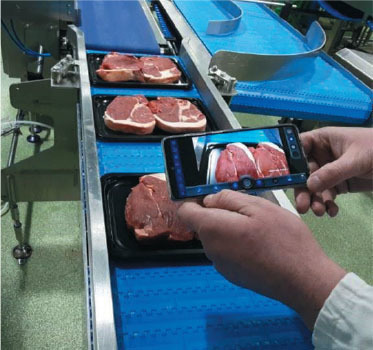 Tesco uses Librestream’s Onsight AR worker platform to allow its auditors to conduct immersive, time-saving virtual audits in remote locations. TESCO
Tesco uses Librestream’s Onsight AR worker platform to allow its auditors to conduct immersive, time-saving virtual audits in remote locations. TESCOTesco selected Librestream’s Onsight AR worker platform to allow its auditors to conduct immersive, time-saving virtual audits in remote locations via an internet connection and their smartphones, computers or wearable devices. Using the Onsight app, a plant or floor worker helps the auditor observe and assess the site and its activities. The auditor can do a thorough product or process audit by marking up video and images for clarity and taking control over the camera to adjust lighting and zoom. The data captured from this audit is automatically saved to a centralized knowledge base where it is shared with relevant team members.
 For greater flexibility, Peter Millar employs LogistiVIEW’s Vision Pick & Put Wall, which utilizes AR-powered enterprise smart glasses, artificial intelligence and computer vision. PETER MILLAR
For greater flexibility, Peter Millar employs LogistiVIEW’s Vision Pick & Put Wall, which utilizes AR-powered enterprise smart glasses, artificial intelligence and computer vision. PETER MILLARTesco’s remote auditing technology also made it easier to collaborate with remote employees and suppliers, and dramatically improved efficiency. For example, a Tesco auditor successfully completed virtual site visits across three countries in a single day. The audits—a product launch in Asia, a packaging approval in Ireland, and a hygiene inspection in Spain—would otherwise require two weeks of time and travel.
Deploying AR-Powered Put Walls to Handle Peak Volumes
Challenged by growth as its omnichannel business grew faster than anticipated, by 2018 retailer Peter Millar—an American lifestyle brand based in Durham, NC—had outgrown its existing warehouse automation. Originally designed for the January e-commerce surge, the fulfillment system could no longer support order proliferation during the peak volume period.
After evaluating multiple technologies, operations managers selected MHI member LogistiVIEW’s Vision Pick & Put Wall. The solution provides both visual and voice-based work instructions through a combination of AR-powered Vuzix M300 enterprise smart glasses, artificial intelligence (AI) and computer vision. Because the put walls are not fixed to the floor, the system can be flexibly expanded or moved elsewhere at any time—addressing both current congestion and future business changes.
“What led us to LogistiVIEW [was]the ability to be dynamic in the execution,” explained Chris Wiest, director of supply chain/operations at Peter Millar. “With one set of glasses I can set up as many put walls as I want, wherever I want in my operation, and use the same functional aspects of the glasses to drive my productivity.”
In the new process, workers consolidate multiple picked items into large totes on carts, wheel them to a put wall, and sort items into individual boxes for each order. Through the AR smart glasses, a virtual put-to-light system is overlaid on real-world pick locations or put wall slots. Intuitive, easy-to-understand visual representations in their line of sight indicate where to go and what to do, backed by simultaneous voice direction. For instance, a correct location is highlighted with a green box, and an incorrect location with a red box. If an error occurs, the system flags the mistake and prompts a correction.
Within 90 days of implementation, Peter Millar saw a 10% reduced load on its conveyor, reduced inventory touches and travel time for pickers, and increased throughput and efficiency in peak season.
“We were able to turn our peak customer orders significantly faster because of the technologies,” added Wiest, who noted that with the new system employees can be trained in minutes instead of the previous weeks. “The workflow tells them exactly what they need to do, so the training time is very low because it’s telling them, scan the tote, scan the products, go to this location. Once they’re comfortable with how to interact with the glasses, they’re up and running very quickly.”
In German chemical and consumer goods manufacturer Henkel’s laundry and home care business, production teams across more than 30 plants worldwide rely on continuous communication to actively share knowledge. Product specialists in the Henkel research and development departments, external manufacturers of production machines, technical support staff, and employees routinely share best practices to drive improvements and collaborate to solve problems—often requiring personnel to travel to different sites.
Henkel recognized that improving their ability to communicate information and assist teams around the world—while also decreasing the need to travel—would have a significant impact on their business. Seeking to reduce operational costs, increase workforce productivity and efficiency, and improve safety and compliance across their operations, Henkel began searching for a remote assistance solution. The company ultimately selected PTC’s Vuforia Chalk, an AR-powered remote assistance app that connects technicians with experts in real-time.
With the system, experts and technicians make digital annotations on a live, shared view of a real-world environment and troubleshoot issues or guide multi-step solutions. The digital annotations are anchored to the technician’s view, making multi-step solutions easy to follow while greatly reducing the potential for mistakes and miscommunication.
 Henkel utilizes PTC’s Vuforia Chalk, an AR-powered remote assistance app that connects technicians with experts in real-time, as a remote assistance solution. HENKEL
Henkel utilizes PTC’s Vuforia Chalk, an AR-powered remote assistance app that connects technicians with experts in real-time, as a remote assistance solution. HENKEL“Because physical observation is often required to solve problems, AR was a perfect fit for our manufacturing operations,” said Stefan Goeris, process consultant manufacturing at Henkel, who noted that the app is easy to download, allowing the company to quickly scale the initiative to all their laundry and home care sites. “And because Chalk is available on mobile devices, tablets, desktops and hands-free devices, we could make it widely available without investing in extra equipment.”
Connection between users is quick and seamless. Using the connect code functionality, the session host can invite another participant into a session once they have the app. Only one of the two parties needs a Chalk license, making it easy for experts or service employees in their home office to assist the technical support teams.
Then, when COVID-19 caused lockdowns and disruptions worldwide and travel became prohibitively difficult and unsafe, Henkel’s experts could no longer travel to assist the production teams or facilitate in-person knowledge transfer. Fortunately, the Vuforia Chalk solution was already in place, and was quickly deployed across all 30 factories. Currently around 200 Henkel employees are using the system, from line workers and machine operators to managers and engineers.
Chalk has become an indispensable tool within the Henkel Group, continued Goeris, who said results have been significant: experts are able to provide high-level troubleshooting, maintenance and support to teams around the world while reducing travel costs and saving time.
“We get productive solutions fast through virtual collaboration,” he said. “COVID-19 will continue to be a challenge for companies worldwide, but even outside of the pandemic, Chalk will remain an important tool that simplifies communication, saves costs, increases workforce productivity and efficiency, and improves safety and compliance.”

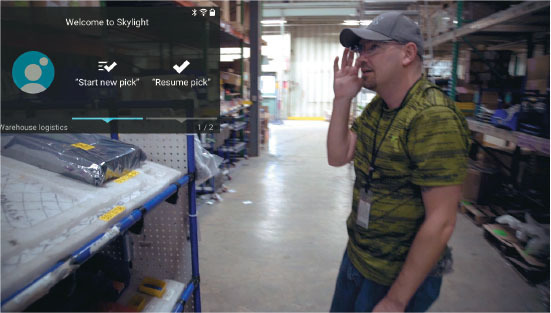
The Skylight industrial AR application platform, which interacts with smart glasses, is used by workers at General Electric to provide more accurate and faster solutions during picking. GENERAL ELECTRIC
Leveraging AR-Directed Picking for Kitting, Order Fulfillment
General Electric, a global leader in manufacturing magnetic resonance imaging (MRI) machinery and other major health care equipment through its GE Healthcare division, stores hundreds of major and minor MRI parts from dozens of suppliers in its Florence, SC, warehouse. The busy, dynamic facility has items stored in multiple locations that move quickly to the floor to fill parts orders and for kitting of multiple parts into sets.
In the past, warehouse workers flipped through printed orders to locate parts and walked, sometimes across the entire warehouse, to a computer workstation as they found depleted stock locations to search for alternates. Operations managers sought a more accurate and faster solution to boost worker performance, ultimately selecting the Skylight industrial AR application platform from Upskill—A TeamViewer Company.
Workers using the Skylight platform can now see the items to be picked displayed on their smart glasses, with details such as item description, quantity needed, and primary and alternate storage locations. The system gives workers pick lists and recommends real-time alternate location suggestions directly in their line of sight.
To confirm picks and get orders, workers say, “Hey Skylight” to activate voice control, then use commands like “scroll forward” and “confirm pick.” If they prefer, they can tap or swipe the touchpad on the glasses to see the options and confirm their choices. If the item is completely out, the worker uses Skylight to mark it “Not in Location” (NIL) and continues to the next item.
On the backend, Skylight integrates with GE’s warehouse management system (WMS) to retrieve the current and alternate locations for each item. As the worker fills the picking cart with parts, the system keeps track of what has been collected, and what couldn’t be located—then prepares a report at the end.
Results have been significant: Using Skylight, the first warehouse worker to fulfill a picklist order on smart glasses completed the task 46% faster than with the existing system. The facility has also seen a reduction in work order errors and faster worker onboarding.
 Pick-by-vision technology by Picavi allows for some tasks to be hands-free. PICAVI GMBH
Pick-by-vision technology by Picavi allows for some tasks to be hands-free. PICAVI GMBHWorkforce Training Program Teaches Forklift Skills with VR Simulation
As more distribution centers were opening in the area, Broome-Tioga Workforce New York—an organization focused on providing employment-related services to local businesses, workers and job seekers—recognized a growing need to find more skilled labor to fill warehouse positions. Without adequate labor, the skills gap posed a serious threat to employers’ growth prosperity and surrounding communities’ ability to attract new businesses to the area.
To address this economic concern, the organization partnered with The State University of New York (SUNY) Broome Community College and Broome-Tioga Board of Cooperative Education Services (BOCES). Together they created the Opportunity Impact Training Program to teach job seeking individuals the needed skills.
In addition to foundational classroom-based courses, team-building lessons and professional development skills building, the curriculum includes forklift operator education utilizing MHI member The Raymond Corp.’s Virtual Reality Simulator. The easy-touse virtual reality (VR) system includes numerous progressive coaching modules to help participants practice the skills needed to operate a forklift and experience what it’s like to be on an actual warehouse floor.
By plugging into an actual Raymond forklift’s sPort, or Simulation Port, the simulator allows the participants to enter a virtual warehousing environment. This helps participants become familiar and comfortable with the feeling of a forklift and its controls prior to operating within a physical warehousing environment. It also allows the student to experience real-life situations otherwise not available through traditional classroom settings.
“The virtual reality technology allowed me to feel like I was operating a forklift in a real warehouse environment,” said one program participant. “It was beneficial practicing how to raise and lower pallets with actual forklift controls. It helped me be more confident about my skills and experience, all before driving a forklift in the warehouse.”
“The Raymond Virtual Reality Simulator was a win-win-win,” said Lynette Bryan, supervisor at the Center of Technical Excellence at BOCES. “It provided a holistic educational experience to round out the curriculum, offered engaging hands-on learning that was more enjoyable for the students, and increased proficiency levels so participants were more prepared when they reached employers.”
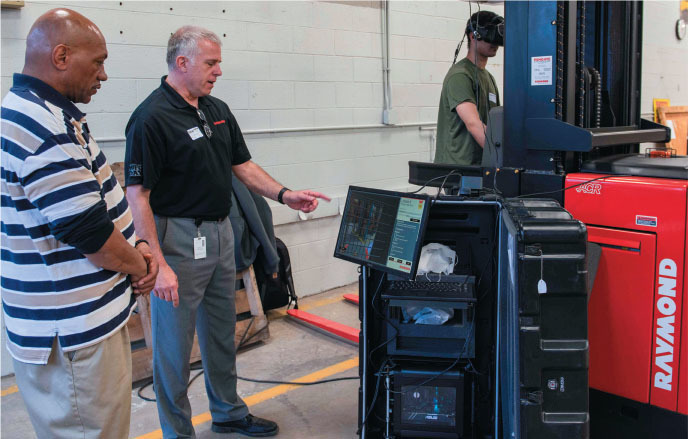
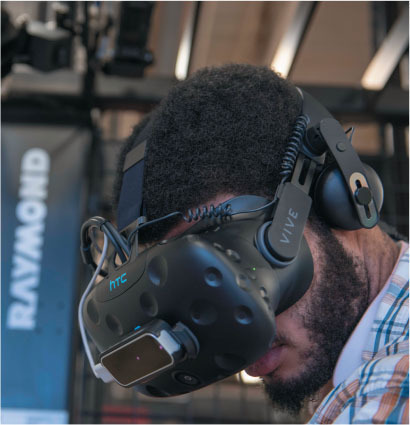
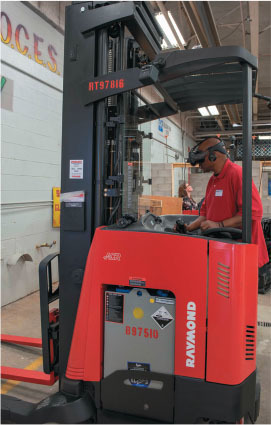 The Raymond Corp.’s Virtual Reality Simulator includes progressive coaching modules to help participants practice the skills needed to operate a forklift—just one of the skills taught to students in the Opportunity Impact Training Program. THE RAYMOND CORP.
The Raymond Corp.’s Virtual Reality Simulator includes progressive coaching modules to help participants practice the skills needed to operate a forklift—just one of the skills taught to students in the Opportunity Impact Training Program. THE RAYMOND CORP. MHI Solutions Improving Supply Chain Performance
MHI Solutions Improving Supply Chain Performance